1995 CHEVROLET S10 oil change
[x] Cancel search: oil changePage 109 of 354
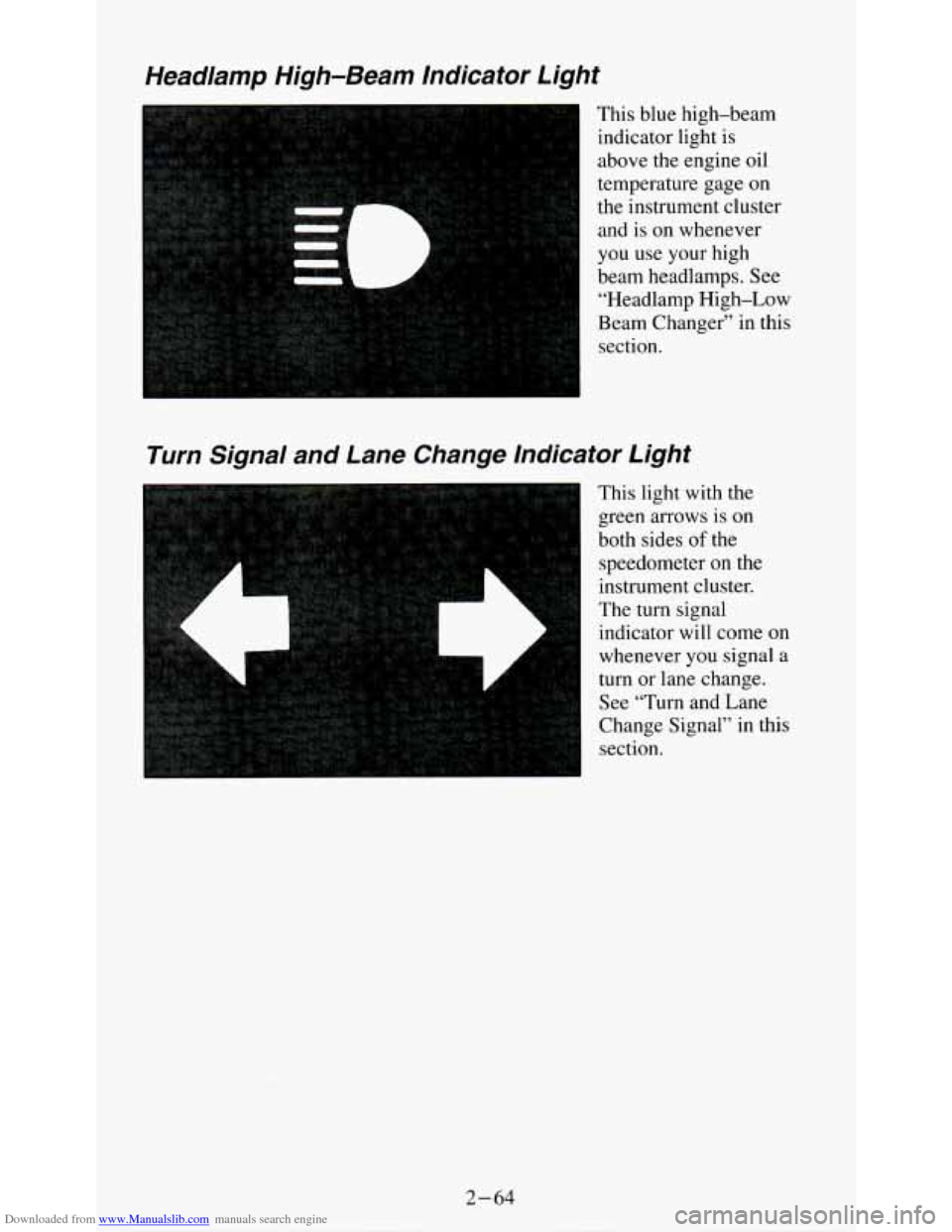
Downloaded from www.Manualslib.com manuals search engine Headlamp High-Beam Indicator Light
A
This blue high-beam
indicator light is
above the engine oil
temperature gage
on
the instrument cluster
and is on whenever
you use your high
beam headlamps. See
“Headlamp High-Low
Beam Changer” in this section.
Turn Signal and Lane Change Indicator Light
This light with the
green arrows is
on
both sides of the
speedometer on the
instrument cluster.
The turn signal
indicator will come on
whenever
you signal a
turn or lane change.
See “Turn and Lane
Change Signal” in this
section.
2-64
Page 226 of 354
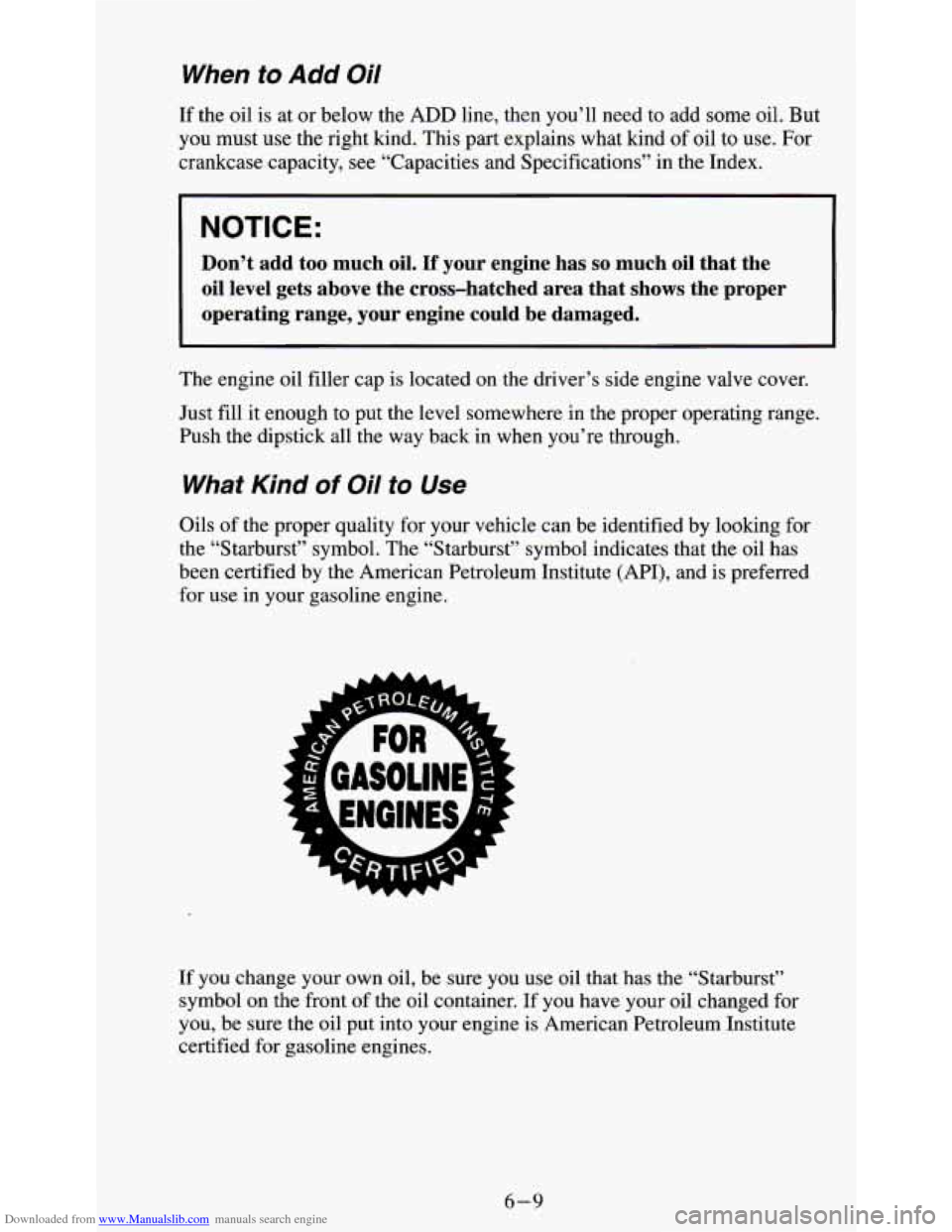
Downloaded from www.Manualslib.com manuals search engine When to Add Oil
If the oil is at or below the ADD line, then you’ll need to add some oil. But
you must
use the right kind. This part explains what kind of oil to use. For
crankcase capacity, see “Capacities and Specifications” in the Index.
I NOTICE:
Don’t add too much oil. If your engine has so much oil that the
oil level gets above the cross-hatched area that shows the pro\
per
operating range, your engine could be damaged.
The engine oil filler cap is located on the driver’s side engine valve cover.
Just fill
it enough to put the level somewhere in the proper operating range.
Push the dipstick all the way back in when you’re through.
What Kind of Oil to Use
Oils of the proper quality for your vehicle can be identified by looking for
the “Starburst” symbol. The “Starburst” symbol indicates that the oil has
been certified by the American Petroleum Institute (API), and is preferred
for use in your gasoline engine.
If you change your own oil, be sure you use oil that has the “Starburst”
symbol on the front
of the oil container. If you have your oil changed for
you, be sure the oil put into your engine is American Petroleum Institute
certified for gasoline engines.
6-9
Page 228 of 354
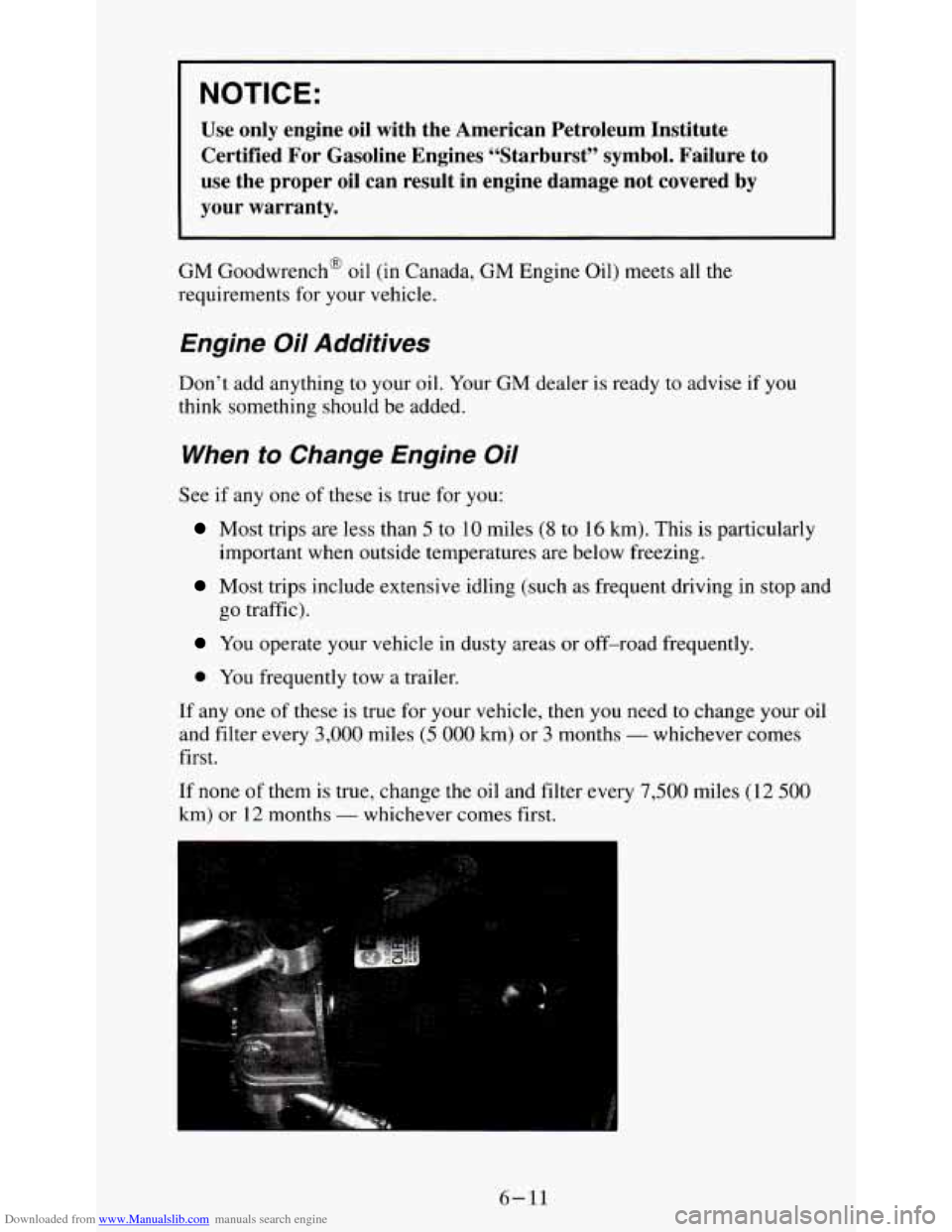
Downloaded from www.Manualslib.com manuals search engine I NOTICE:
Use only engine oil with the American Petroleum Institute Certified For Gasoline Engines “Starburst” symbol. Failure \
to
use the proper oil can result in engine damage not covered by
your warranty.
GM Goodwrench@ oil (in Canada, GM Engine Oil) meets all the
requirements for your vehicle.
Engine Oil Additives
Don’t add anything to your oil. Your GM dealer is ready to advise if you
think something should be added.
When to Change Engine Oil
See if any one of these is true for you:
Most trips are less than 5 to 10 miles (8 to 16 km). This is particularly
important when outside temperatures are below freezing.
Most trips include extensive idling (such as frequent driving in stop and
go traffic).
You operate your vehicle in dusty areas or off-road frequently.
0 You frequently tow a trailer.
If any one of these is true for your vehicle, then
you need to change your oil
and filter every
3,000 miles (5 000 km) or 3 months - whichever comes
first.
If none of them is true, change the
oil and filter every 7,500 miles (12 500
km) or 12 months - whichever comes first.
6- 11
Page 229 of 354
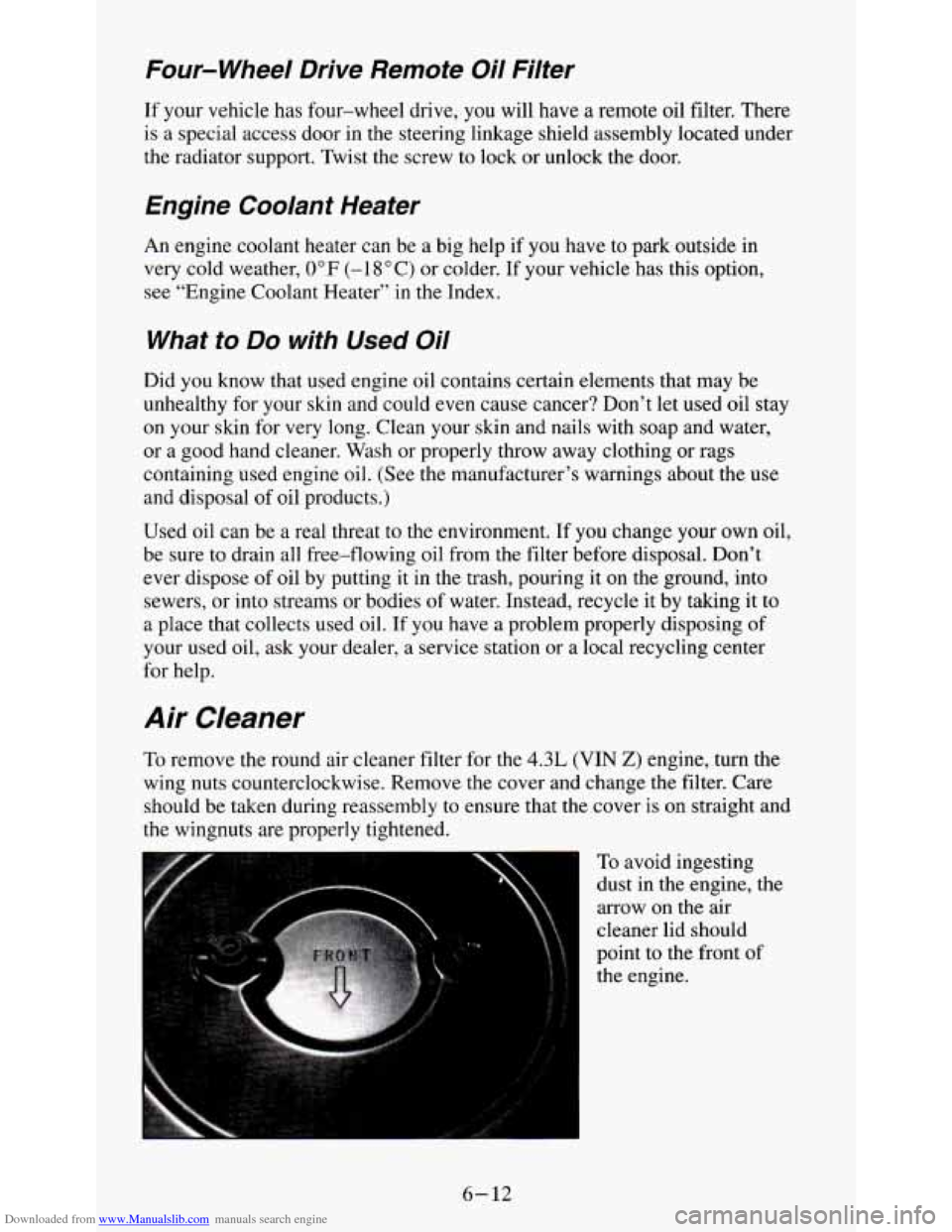
Downloaded from www.Manualslib.com manuals search engine Four-wheel Drive Remote Oil Filter
If your vehicle has four-wheel drive, you will have a remote oil filter. There
is a special access door in the steering linkage shield assembly located under
the radiator support. Twist the screw to lock or unlock the door.
Engine Coolant Heater
An engine coolant heater can be a big help if you have to park outside in
very cold weather,
0°F (-1 8 O C) or colder. If your vehicle has this option,
see “Engine Coolant Heater” in the Index.
What to Do with Used Oil
Did you know that used engine oil contains certain elements that may be
unhealthy for your skin and could
even cause cancer? Don’t let used oil stay
on your skin for very long. Clean your skin and nails with soap and water,
or a good hand cleaner. Wash or properly throw away clothing or rags
containing used engine oil. (See the manufacturer’s warnings about the use
and disposal of oil products.)
Used oil can be a real threat to the environment. If you change your own oil,
be sure to drain all free-flowing oil from the filter before disposal. Don’t
ever dispose of oil by putting
it in the trash, pouring it on the ground, into
sewers, or into streams or bodies of water. Instead, recycle it by taking it
to
a place that collects used oil. If you have a problem properly disposing of
your used oil, ask your dealer, a service station or a local recycling center
for help.
Air Cleaner
To remove the round air cleaner filter for the 4.3L (VIN 2) engine, turn the
wing nuts counterclockwise. Remove the cover and change the filter. Care
should be taken during reassembly to ensure that the cover is on straight and
the wingnuts
are properly tightened.
= To avoid ingesting
dust in the engine, the
arrow on the air
cleaner lid should
point
to the front of
the engine.
6- 12
Page 231 of 354
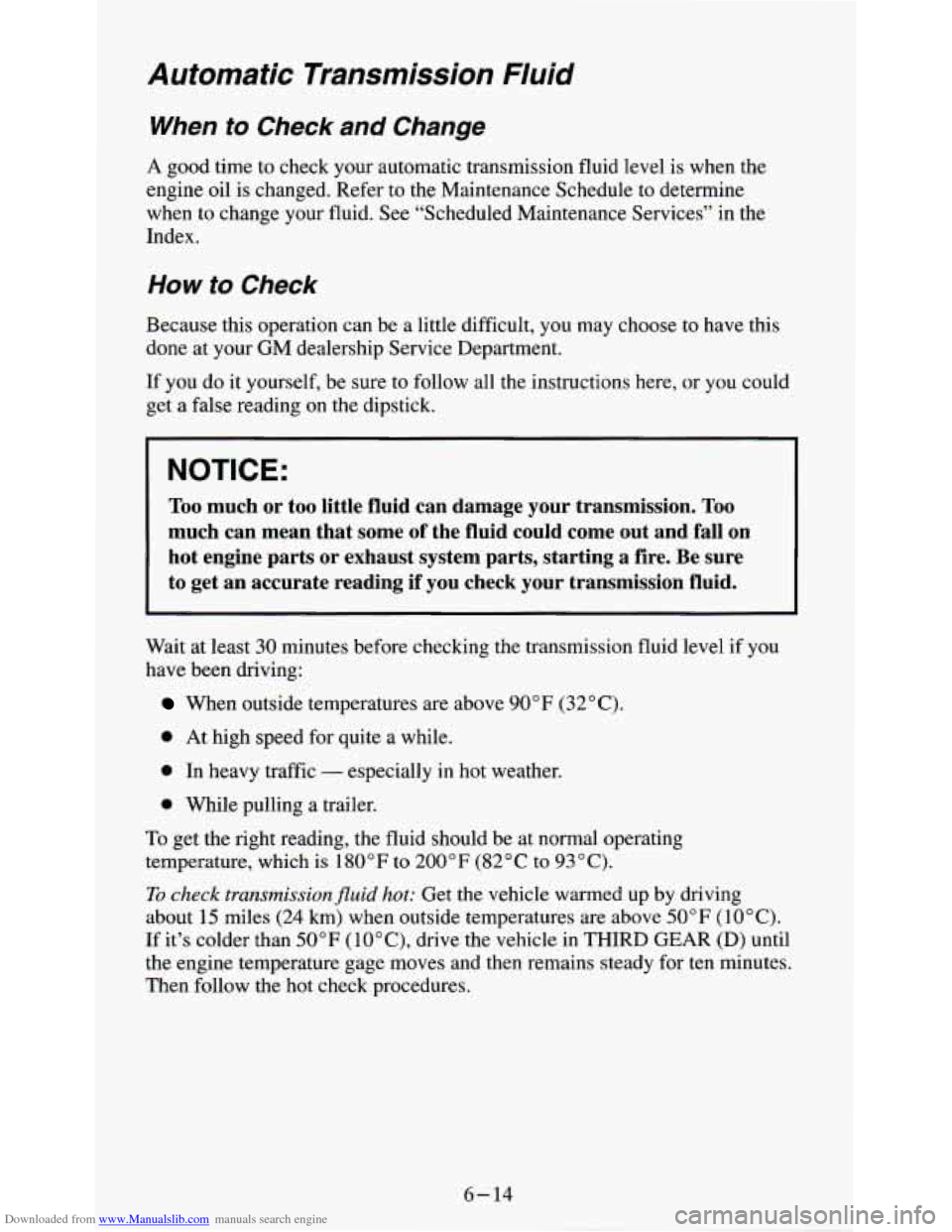
Downloaded from www.Manualslib.com manuals search engine Automatic Transmission Fluid
When to Check and Change
A good time to check your automatic transmission fluid level is when the
engine oil is changed. Refer to the Maintenance Schedule to determine
when to change your fluid. See “Scheduled Maintenance Services” in the
Index.
How to Check
Because this operation can be a little difficult, you may choose to have this
done at your GM dealership Service Department.
If
you do it yourself, be sure to follow all the instructions here, or you could
get a false reading on the dipstick.
I NOTICE:
Too much or too little fluid can damage your transmission. Too
much can mean that some of the fluid could come out and fall\
on
hot engine parts or exhaust system parts, starting a fire. Be sure
to get an accurate reading if you check your transmission fluid.
Wait at least 30 minutes before checking the transmission fluid level if you
have been driving:
When outside temperatures are above 90°F (32°C).
0 At high speed for quite a while.
0 In heavy traffic - especially in hot weather.
0 While pulling a trailer.
To get the right reading, the fluid should be at normal operating
temperature, which
is 180°F to 200°F (82°C to 93°C).
To check transmission fluid hot: Get the vehicle warmed up by driving
about
15 miles (24 krn) when outside temperatures are above 50°F ( 1 0°C).
If it’s colder than 50°F (lO”C), drive the vehicle in THIRD GEAR (D) until
the engine temperature gage moves and then remains steady for ten minutes.
Then follow the hot check procedures.
6- 14
Page 234 of 354
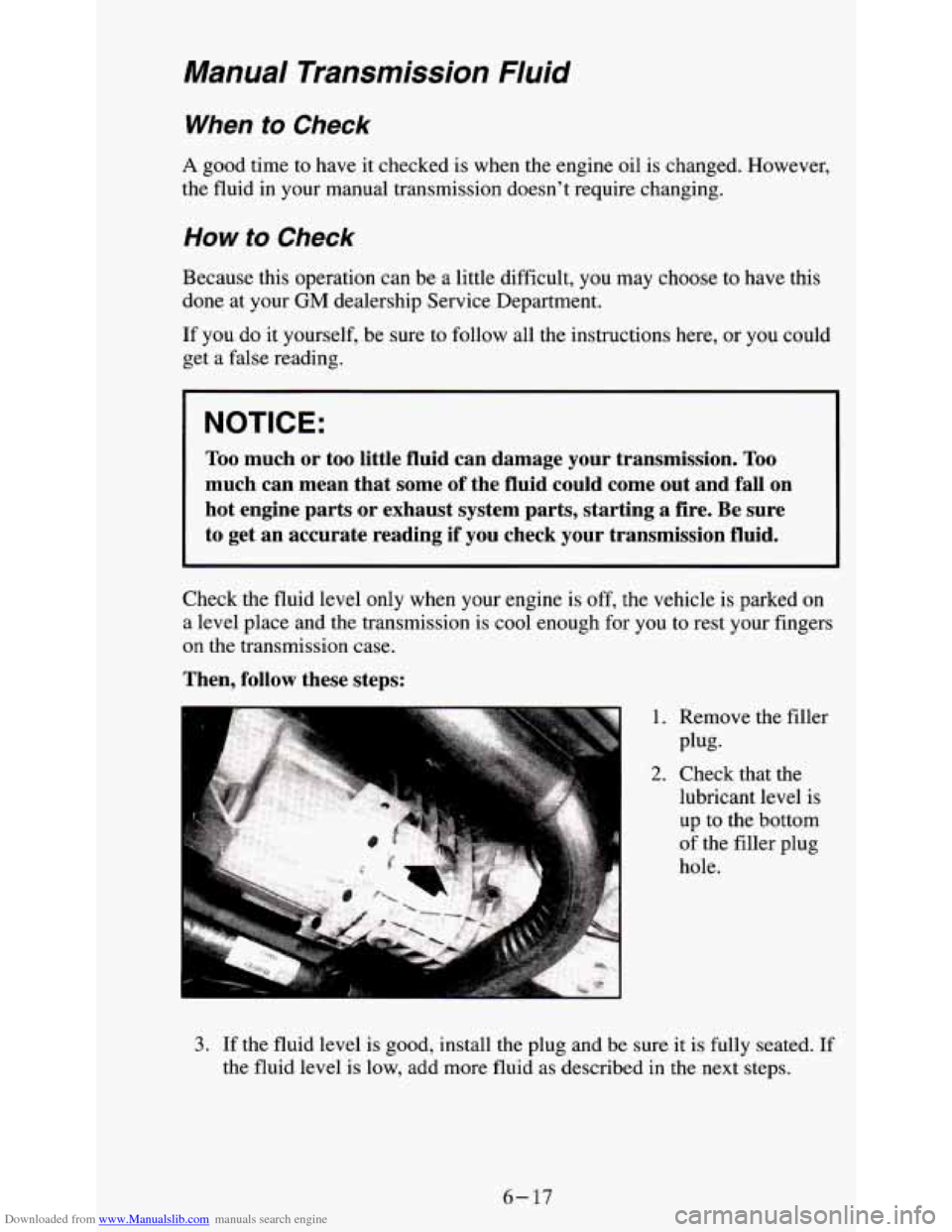
Downloaded from www.Manualslib.com manuals search engine Manual Transmission Fluid
When to Check
A good time to have it checked is when the engine oil is changed. However,
the fluid in your manual transmission doesn't require changing.
How to Check
Because this operation can be a little difficult, you may choose to have this
done at your
GM dealership Service Department.
If you do it yourself, be sure to follow all the instructions here, or you could
get a false reading.
NOTICE:
Too much or too little fluid can damage your transmission. Too
much can mean that some of the fluid could come out and fall on
hot engine parts or exhaust system parts, starting a fire. Be sure
to get an accurate reading if
you check your transmission fluid.
Check the fluid level only when your engine is off, the vehicle is parked on
a level place and the transmission is cool enough for
you to rest your fingers
on the transmission case.
Then, follow these steps:
h
1. Remove the filler
Plug-
2. Check that the
lubricant level is
up to the bottom
of the filler plug
hole.
3. If the fluid level is good, install the plug and be sure it is fully seated. If
the fluid level is low, add more fluid as described in the next steps.
6-17
Page 288 of 354
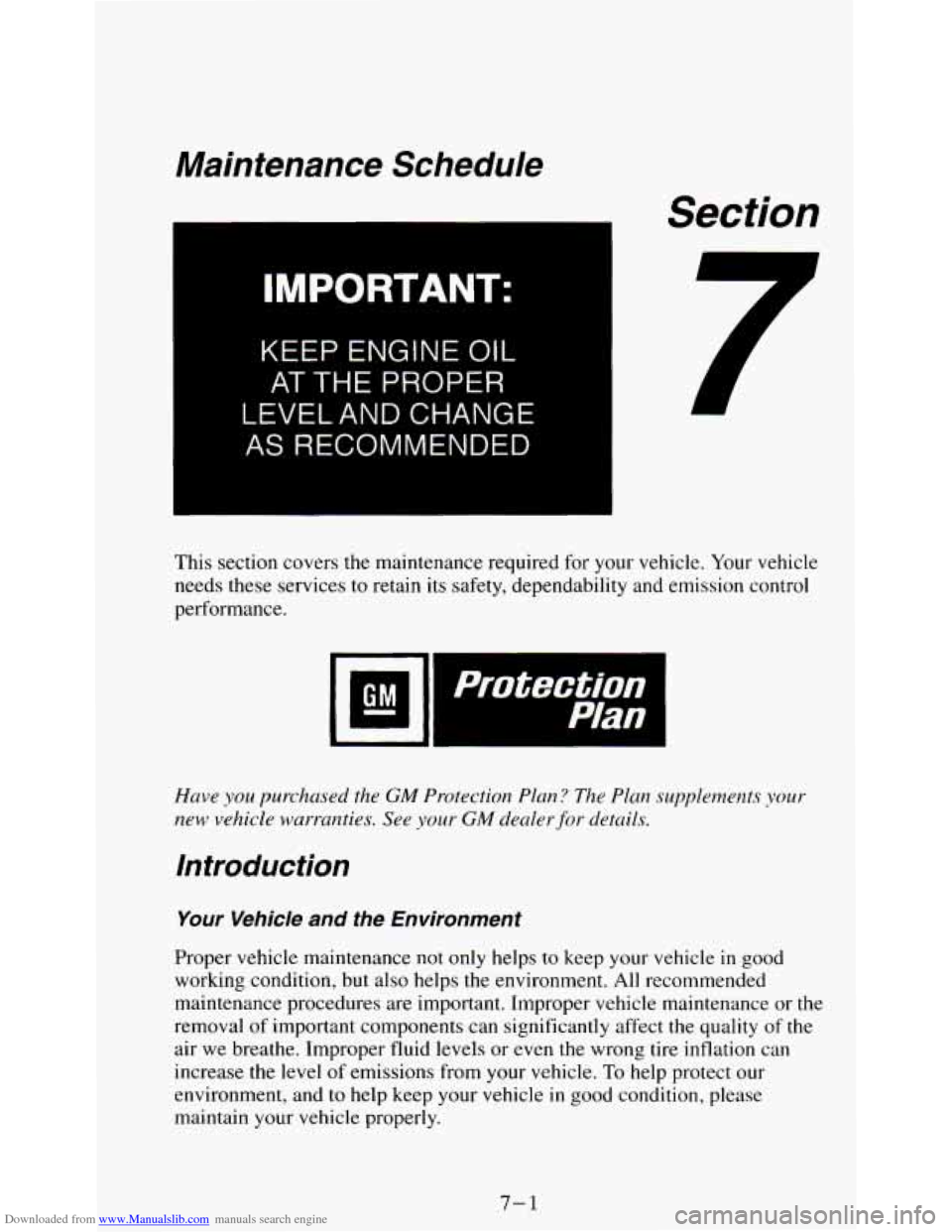
Downloaded from www.Manualslib.com manuals search engine Maintenance Schedule
IMPORTANT:
KEEP ENGINE OIL
AT THE PROPER
LEVEL AND CHANGE
AS RECOMMENDED
Section
7
This section covers the maintenance required for your vehicle. Your vehicle
needs these services
to retain its safety, dependability and emission control
performance.
Have you purchased the GM Protection Plan.? The Plan sctpplem.ent,s yo~~r
new vehicle warranties. See your GM dealerafor detuils.
Introduction
Your Vehicle and the ~ vironment
Proper vehicle maintenance not only helps to keep your vehicle in good
working condition, but
also helps the environment. All recommended
maintenance procedures are important. Improper vehicle maintenance or the
removal
of important components can significantly affect the quality of the
air we breathe. Improper fluid levels or even
the wrong tire inflation can
increase the level
of emissions from your vehicle. To help protect our
environment, and
to help keep your vehicle in good condition, please
maintain your vehicle properly.
7-1
Page 291 of 354
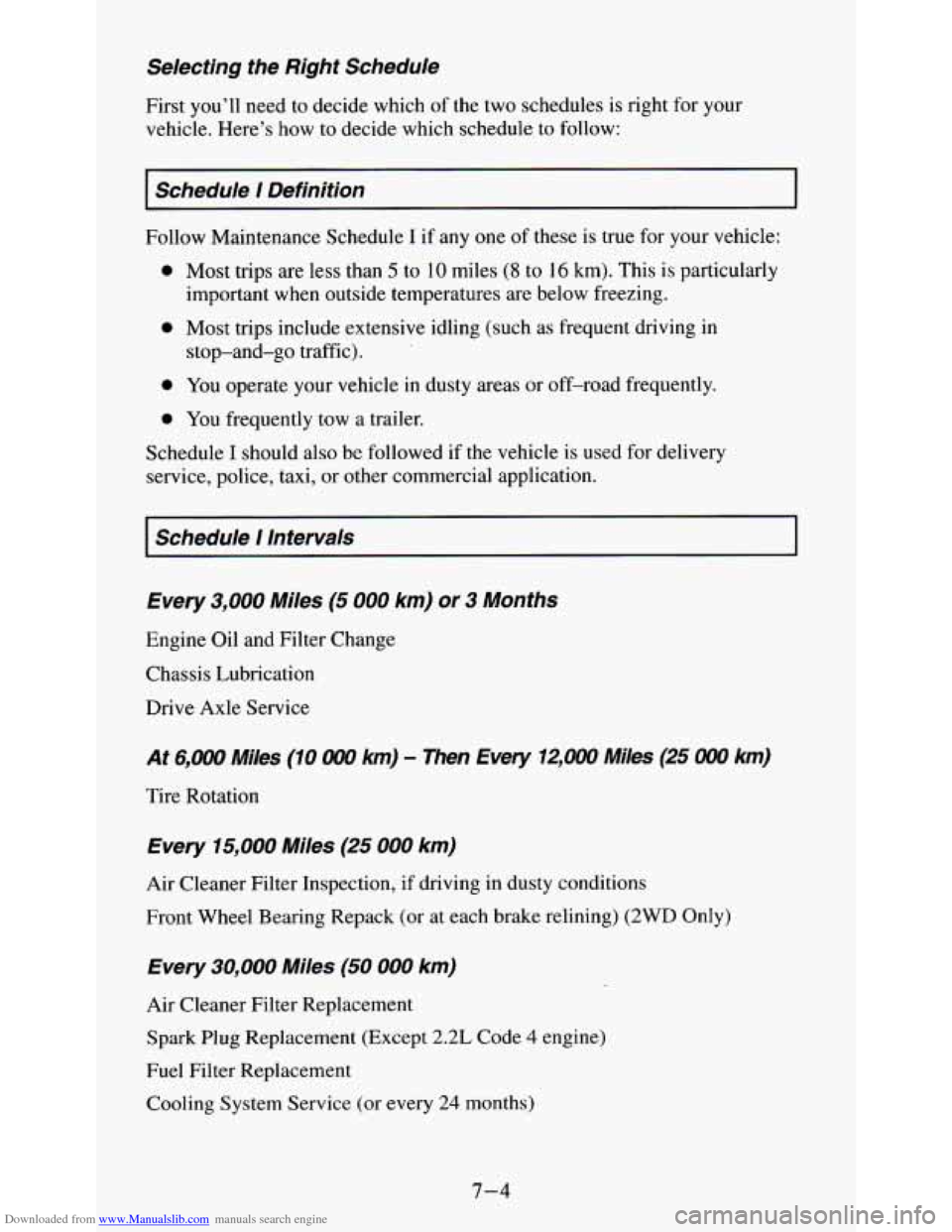
Downloaded from www.Manualslib.com manuals search engine Selecting the Right Schedule
First you’ll need to decide which of the two schedules is right for your
vehicle. Here’s how to decide which schedule to follow:
I Schedule I Definition I
Follow Maintenance Schedule I if any one of these is true for your vehicle:
0 Most trips are less than 5 to 10 miles (8 to 16 km). This is particularly
0 Most trips include extensive idling (such as frequent driving in
0 You operate your vehicle in dusty areas or off-road frequently.
0 You frequently tow a trailer.
important
when outside temperatures are below freezing.
stop-and-go traffic).
Schedule
I should also be followed if the vehicle is used for delivery
service, police, taxi, or other commercial application.
I Schedule I Intervals I
Every 3,000 Miles (5 000 km) or 3 Months
Engine Oil and Filter Change
Chassis Lubrication
Drive Axle Service
At 6,000 Miles (10 OOO km) - Then Every 12,000 Miles (25 OOO km)
Tire Rotation
Every 15,000 Miles (25 000 km)
Air Cleaner Filter Inspection, if driving in dusty conditions
Front Wheel Bearing Repack (or at each brake relining) (2WD Only)
Every 30,000 Miles (50 000 km)
Air Cleaner Filter Replacement
Spark Plug Replacement (Except
2.2L Code 4 engine)
Fuel Filter Replacement
Cooling System Service (or every 24 months)
7-4